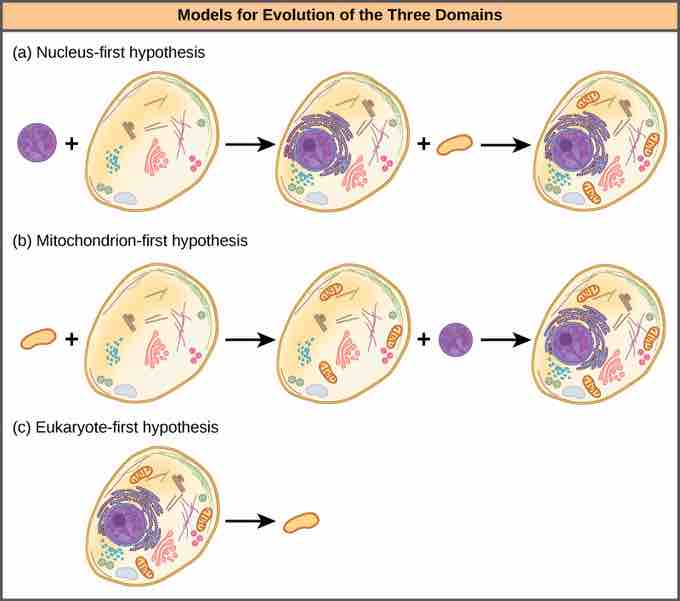Genome Fusion and the Evolution of Eukaryotes
Scientists believe the ultimate event in HGT (horizontal gene transfer) occurs through genome fusion between different species when two symbiotic organisms become endosymbiotic. This occurs when one species is taken inside the cytoplasm of another species, which ultimately results in a genome consisting of genes from both the endosymbiont and the host. This mechanism is an aspect of the Endosymbiont Theory, which is accepted by a majority of biologists as the mechanism whereby eukaryotic cells obtained their mitochondria and chloroplasts. However, the role of endosymbiosis in the development of the nucleus is more controversial. Nuclear and mitochondrial DNA are thought to be of different (separate) evolutionary origin, with the mitochondrial DNA being derived from the circular genomes of bacteria that were engulfed by ancient prokaryotic cells. Mitochondrial DNA can be regarded as the smallest chromosome. Interestingly enough, mitochondrial DNA is inherited only from the mother. The mitochondrial DNA degrades in sperm when the sperm degrades in the fertilized egg or, in other instances, when the mitochondria located in the flagellum of the sperm fails to enter the egg.
Within the past decade, the process of genome fusion by endosymbiosis has been proposed to be responsible for the evolution of the first eukaryotic cells . Using DNA analysis and a new mathematical algorithm called conditioned reconstruction (CR), it has been proposed that eukaryotic cells developed from an endosymbiotic gene fusion between two species: one an Archaea and the other a Bacteria. As mentioned, some eukaryotic genes resemble those of Archaea, whereas others resemble those from Bacteria. An endosymbiotic fusion event would clearly explain this observation. On the other hand, this work is new and the CR algorithm is relatively unsubstantiated, which causes many scientists to resist this hypothesis.

Endosymbiosis in eukaryotes
The theory that mitochondria and chloroplasts are endosymbiotic in origin is now widely accepted. More controversial is the proposal that (a) the eukaryotic nucleus resulted from the fusion of archaeal and bacterial genomes; and that (b) Gram-negative bacteria, which have two membranes, resulted from the fusion of Archaea and Gram-positive bacteria, each of which has a single membrane.
More recent work proposes that gram-negative bacteria, which are unique within their domain in that they contain two lipid bilayer membranes, did result from an endosymbiotic fusion of archaeal and bacterial species . The double membrane would be a direct result of endosymbiosis, with the endosymbiont picking up the second membrane from the host as it was internalized. This mechanism has also been used to explain the double membranes found in mitochondria and chloroplasts. A lot of skepticism still surrounds this hypothesis; the ideas are still debated within the biological science community.
There are several other competing hypotheses as to the origin of eukaryotes and the nucleus. One idea about how the eukaryotic nucleus evolved is that prokaryotic cells produced an additional membrane which surrounded the bacterial chromosome. Some bacteria have the DNA enclosed by two membranes; however, there is no evidence of a nucleolus or nuclear pores. Other proteobacteria also have membrane-bound chromosomes. If the eukaryotic nucleus evolved this way, we would expect one of the two types of prokaryotes to be more closely-related to eukaryotes. Another hypothesis, the nucleus-first hypothesis, proposes the nucleus evolved in prokaryotes first, followed by a later fusion of the new eukaryote with bacteria that became mitochondria. The mitochondria-first hypothesis, however, proposes mitochondria were first established in a prokaryotic host, which subsequently acquired a nucleus (by fusion or other mechanisms) to become the first eukaryotic cell. Most interestingly, the eukaryote-first hypothesis proposes prokaryotes actually evolved from eukaryotes by losing genes and complexity . All of these hypotheses are testable. Only time and more experimentation will determine which hypothesis is best supported by data.

Three hypotheses of eukaryotic and prokaryotic evolution
Three alternate hypotheses of eukaryotic and prokaryotic evolution are (a) the nucleus-first hypothesis, (b) the mitochondrion-first hypothesis, and (c) the eukaryote-first hypothesis.